Electrical Monitoring as a Novel Route to Understanding the Aging Mechanisms of Carbon Nanotube-Doped Adhesive Film Joints
Abstract
Featured Application
Abstract
1. Introduction
2. Materials and Methods
2.1. Materials
2.2. Aging Tests
2.3. Electromechanical Tests
2.4. Characterization
3. Results
3.1. Water uptake Measurements
3.2. DSC Measurements
3.3. Single Lap Shear Tests
3.4. Electrical Monitoring
3.5. Theoretical Approach
4. Conclusions
Author Contributions
Funding
Conflicts of Interest
References
- Hussey, R.; Wilson, J. Structural Adhesives: Directory and Databook; Springer Science & Business Media: Berlin/Heidelberg, Germany, 1996. [Google Scholar]
- Palaniappan, J.; Wang, H.; Ogin, S.L.; Thorne, A.M.; Reed, G.T.; Crocombe, A.D.; Rech, Y.; Tjin, S.C. Changes in the reflected spectra of embedded chirped fibre Bragg gratings used to monitor disbonding in bonded composite joints. Compos. Sci. Technol. 2007, 67, 2847–2853. [Google Scholar] [CrossRef]
- Palaniappan, J.; Ogin, S.L.; Thorne, A.M.; Reed, G.T.; Crocombe, A.D.; Capell, T.F.; Tjin, S.C.; Mohanty, L. Disbond growth detection in composite-composite single-lap joints using chirped FBG sensors. Compos. Sci. Technol. 2008, 68, 2410–2417. [Google Scholar] [CrossRef]
- Bernasconi, A.; Carboni, M.; Comolli, L. Monitoring of fatigue crack growth in composite adhesively bonded joints using fiber Bragg gratings. Procedia Eng. 2011, 10, 207–212. [Google Scholar] [CrossRef]
- Ruoff, R.S.; Lorents, D.C. Mechanical and thermal properties of carbon nanotubes. Carbon 1995, 33, 925–930. [Google Scholar] [CrossRef]
- Yu, M.F.; Lourie, O.; Dyer, M.J.; Moloni, K.; Kelly, T.F.; Ruoff, R.S. Strength and breaking mechanism of multiwalled carbon nanotubes under tensile load. Science 2000, 287, 637–640. [Google Scholar] [CrossRef]
- De Volder, M.F.L.; Tawfick, S.H.; Baughman, R.H.; Hart, A.J. Carbon Nanotubes: Present and Future Commercial Applications. Science 2013, 339, 535–539. [Google Scholar] [CrossRef]
- Hu, N.; Masuda, Z.; Yan, C.; Yamamoto, G.; Fukunaga, H.; Hashida, T. The electrical properties of polymer nanocomposites with carbon nanotube fillers. Nanotechnology 2008, 19, 215701. [Google Scholar] [CrossRef]
- Wang, M.; Zhang, K.; Dai, X.; Li, Y.; Guo, J.; Liu, H.; Li, G.; Tan, Y.; Zeng, J.; Guo, Z. Enhanced electrical conductivity and piezoresistive sensing in multi-wall carbon nanotubes/polydimethylsiloxane nanocomposites via the construction of a self-segregated structure. Nanoscale 2017, 9, 11017–11026. [Google Scholar] [CrossRef]
- Chen, J.; Han, J.; Xu, D. Thermal and electrical properties of the epoxy nanocomposites reinforced with purified carbon nanotubes. Mater. Lett. 2019, 246, 20–23. [Google Scholar] [CrossRef]
- Plyushch, A.; Lyakhov, D.; Šimėnas, M.; Bychanok, D.; Macutkevič, J.; Michels, D.; Banys, J.; Lamberti, P.; Kuzhir, P. Percolation and Transport Properties in The Mechanically Deformed Composites Filled with Carbon Nanotubes. Appl. Sci. 2020, 10, 1315. [Google Scholar] [CrossRef]
- Ferreira, A.D.B.L.; Nóvoa, P.R.O.; Marques, A.T. Multifunctional Material Systems: A state-of-the-art review. Compos. Struct. 2016, 151, 3–35. [Google Scholar] [CrossRef]
- Mederos-Henry, F.; Mesfin, H.; Danlée, Y.; Jaiswar, R.; Delcorte, A.; Bailly, C.; Hermans, S.; Huynen, I. Smart Nanocomposites for Nanosecond Signal Control: The Nano4waves Approach. Appl. Sci. 2020, 10, 1102. [Google Scholar] [CrossRef]
- Gong, S.; Zhu, Z. Giant piezoresistivity in aligned carbon nanotube nanocomposite: Account for nanotube structural distortion at crossed tunnel junctions. Nanoscale 2015, 7, 1339–1348. [Google Scholar] [CrossRef] [PubMed]
- Pu, J.; Zha, X.; Zhao, M.; Li, S.; Bao, R.; Liu, Z.; Xie, B.; Yang, M.; Guo, Z.; Yang, W. 2D end-to-end carbon nanotube conductive networks in polymer nanocomposites: A conceptual design to dramatically enhance the sensitivities of strain sensors. Nanoscale 2018, 10, 2191–2198. [Google Scholar] [CrossRef]
- Avilés, F.; Oliva, A.I.; Ventura, G.; May-Pat, A.; Oliva-Avilés, A.I. Effect of carbon nanotube length on the piezoresistive response of poly (methyl methacrylate) nanocomposites. Eur. Polym. J. 2019, 110, 394–402. [Google Scholar] [CrossRef]
- Kumar, S.; Falzon, B.G.; Hawkins, S.C. Ultrasensitive embedded sensor for composite joints based on a highly aligned carbon nanotube web. Carbon 2019, 149, 380–389. [Google Scholar] [CrossRef]
- Vietri, U.; Guadagno, L.; Raimondo, M.; Vertuccio, L.; Lafdi, K. Nanofilled epoxy adhesive for structural aeronautic materials. Compos. Part B Eng. 2014, 61, 73–83. [Google Scholar] [CrossRef]
- Gude, M.R.; Prolongo, S.G.; Urena, A. Toughening effect of carbon nanotubes and carbon nanofibres in epoxy adhesives for joining carbon fibre laminates. Int. J. Adhes. Adhes. 2015, 62, 139–145. [Google Scholar] [CrossRef]
- Akpinar, I.A.; Gültekin, K.; Akpinar, S.; Akbulut, H.; Ozel, A. Research on strength of nanocomposite adhesively bonded composite joints. Compos. Part B Eng. 2017, 126, 143–152. [Google Scholar] [CrossRef]
- Akpinar, I.A.; Gültekin, K.; Akpinar, S.; Akbulut, H.; Ozel, A. Experimental analysis on the single-lap joints bonded by a nanocomposite adhesives which obtained by adding nanostructures. Compos. Part B Eng. 2017, 110, 420–428. [Google Scholar] [CrossRef]
- Lim, A.S.; Melrose, Z.R.; Thostenson, E.T.; Chou, T. Damage sensing of adhesively-bonded hybrid composite/steel joints using carbon nanotubes. Compos. Sci. Technol. 2011, 71, 1183–1189. [Google Scholar] [CrossRef]
- Mactabi, R.; Rosca, I.D.; Hoa, S.V. Monitoring the integrity of adhesive joints during fatigue loading using carbon nanotubes. Compos. Sci. Technol. 2013, 78, 1–9. [Google Scholar] [CrossRef]
- Kang, M.; Choi, J.; Kweon, J. Fatigue life evaluation and crack detection of the adhesive joint with carbon nanotubes. Compos. Struct. 2014, 108, 417–422. [Google Scholar] [CrossRef]
- Sandler, J.; Shaffer, M.; Prasse, T.; Bauhofer, W.; Schulte, K.; Windle, A. Development of a dispersion process for carbon nanotubes in an epoxy matrix and the resulting electrical properties. Polymer 1999, 40, 5967–5971. [Google Scholar] [CrossRef]
- Prolongo, S.G.; Buron, M.; Gude, M.R.; Chaos-Moran, R.; Campo, M.; Urena, A. Effects of dispersion techniques of carbon nanofibers on the thermo-physical properties of epoxy nanocomposites. Compos. Sci. Technol. 2008, 68, 2722–2730. [Google Scholar] [CrossRef]
- Chakraborty, A.K.; Plyhm, T.; Barbezat, M.; Necola, A.; Terrasi, G.P. Carbon nanotube (CNT)–epoxy nanocomposites: a systematic investigation of CNT dispersion. J. Nanoparticle Res. 2011, 13, 6493–6506. [Google Scholar] [CrossRef]
- Fernández Sánchez-Romate, X.X.; Molinero, J.; Jiménez-Suárez, A.; Sánchez, M.; Güemes, A.; Ureña, A. Carbon Nanotube Doped Adhesive Films for Detecting Crack Propagation on Bonded Joints: A Deeper Understanding of Anomalous Behaviors. ACS Appl. Mater. Interfaces 2017, 9, 43267–43274. [Google Scholar] [CrossRef]
- Sánchez-Romate, X.F.; Baena, L.; Jiménez-Suárez, A.; Sánchez, M.; Güemes, A.; Ureña, A. Exploring the mechanical and sensing capabilities of multi-material bonded joints with carbon nanotube-doped adhesive films. Compos. Struct. 2019, 229, 111477. [Google Scholar] [CrossRef]
- Sánchez-Romate, X.F.; Moriche, R.; Jiménez-Suárez, A.; Sánchez, M.; Güemes, A.; Ureña, A. An approach using highly sensitive carbon nanotube adhesive films for crack growth detection under flexural load in composite structures. Compos. Struct. 2019, 224, 111087. [Google Scholar] [CrossRef]
- Sánchez-Romate, X.F.; Jiménez-Suarez, A.; Molinero, J.; Sánchez, M.; Güemes, A.; Ureña, A. Development of Bonded Joints Using Novel CNT Doped Adhesive Films: Mechanical and Electrical Properties. Int. J. Adhes. Adhes. 2018, 86, 98–104. [Google Scholar] [CrossRef]
- Vaisman, L.; Wagner, H.D.; Marom, G. The role of surfactants in dispersion of carbon nanotubes. Adv. Colloid Interface Sci. 2006, 128, 37–46. [Google Scholar] [CrossRef]
- Rastogi, R.; Kaushal, R.; Tripathi, S.K.; Sharma, A.L.; Kaur, I.; Bharadwaj, L.M. Comparative study of carbon nanotube dispersion using surfactants. J. Colloid Interface Sci. 2008, 328, 421–428. [Google Scholar] [CrossRef]
- Moshammer, K.; Hennrich, F.; Kappes, M.M. Selective suspension in aqueous sodium dodecyl sulfate according to electronic structure type allows simple separation of metallic from semiconducting single-walled carbon nanotubes. Nano Res. 2009, 2, 599–606. [Google Scholar] [CrossRef]
- Zhao, P.; Einarsson, E.; Lagoudas, G.; Shiomi, J.; Chiashi, S.; Maruyama, S. Tunable separation of single-walled carbon nanotubes by dual-surfactant density gradient ultracentrifugation. Nano Res. 2011, 4, 623–634. [Google Scholar] [CrossRef]
- Lawrence, A.; Pearson, J. Electrical properties of soap water amphiphile systems. Electrical conductance and sodium ion activity of aqueous 2% sodium dodecyl sulphate with added homologous n-aliphatic C 2–7 alcohols. Trans. Faraday Soc. 1967, 63, 495–504. [Google Scholar] [CrossRef]
- Song, Y.; Wang, F.; Guo, G.; Luo, S.; Guo, R. Amphiphilic-Polymer-Coated Carbon Nanotubes as Promoters for Methane Hydrate Formation. ACS Sustain. Chem. Eng. 2017, 5, 9271–9278. [Google Scholar] [CrossRef]
- Weiss, J.; Voigt, M.; Kunze, C.; Sanchez, J.E.H.; Possart, W.; Grundmeier, G. Ageing mechanisms of polyurethane adhesive/steel interfaces. Int. J. Adhes. Adhes. 2016, 70, 167–175. [Google Scholar] [CrossRef]
- Mora, V.B.; Mieloszyk, M.; Ostachowicz, W. Model of moisture absorption by adhesive joint. Mech. Syst. Signal. Process. 2018, 99, 534–549. [Google Scholar] [CrossRef]
- Gurtin, M.E.; Yatomi, C. On a model for two phase diffusion in composite materials. J. Compos. Mater. 1979, 13, 126–130. [Google Scholar] [CrossRef]
- Bal, S.; Saha, S. Effect of sea and distilled water conditioning on the overall mechanical properties of carbon nanotube/epoxy composites. Int. J. Damage Mech. 2017, 26, 758–770. [Google Scholar] [CrossRef]
- Kondrashov, S.; Merkulova, Y.I.; Marakhovskii, P.; D’yachkova, T.; Shashkeev, K.; Popkov, O.; Startsev, O.; Molokov, M.; Kurshev, E.; Yurkov, G.Y. Degradation of physicomechanical properties of epoxy nanocomposites with carbon nanotubes upon heat and humidity aging. Russ. J. Appl. Chem. 2017, 90, 788–796. [Google Scholar] [CrossRef]
- Prolongo, S.G.; Gude, M.R.; Urena, A. Water uptake of epoxy composites reinforced with carbon nanofillers. Compos. Part A Appl. Sci. Manuf. 2012, 43, 2169–2175. [Google Scholar] [CrossRef]
- Liu, L.; Tan, S.J.; Horikawa, T.; Do, D.; Nicholson, D.; Liu, J. Water adsorption on carbon-A review. Adv. Colloid Interface Sci. 2017, 250, 64–78. [Google Scholar] [CrossRef]
- Bystrzejewski, M.; Huczko, A.; Lange, H.; Gemming, T.; Büchner, B.; Rümmeli, M.H. Dispersion and diameter separation of multi-wall carbon nanotubes in aqueous solutions. J. Colloid Interface Sci. 2010, 345, 138–142. [Google Scholar] [CrossRef]
- Kastrisianaki-Guyton, E.S.; Chen, L.; Rogers, S.E.; Cosgrove, T.; van Duijneveldt, J.S. Adsorption of sodium dodecylsulfate on single-walled carbon nanotubes characterised using small-angle neutron scattering. J. Colloid Interface Sci. 2016, 472, 1–7. [Google Scholar] [CrossRef]
- Tsutsumi, Y.; Fujigaya, T.; Nakashima, N. Polymer synthesis inside a nanospace of a surfactant–micelle on carbon nanotubes: creation of highly-stable individual nanotubes/ultrathin cross-linked polymer hybrids. Rsc. Adv. 2014, 4, 6318–6323. [Google Scholar] [CrossRef]
- Carter, H.G.; Kibler, K.G. Langmuir-Type Model for Anomalous Moisture Diffusion in Composite Resins. J. Compos. Mater. 1978, 12, 118–131. [Google Scholar] [CrossRef]
- Popineau, S.; Rondeau-Mouro, C.; Sulpice-Gaillet, C.; Shanahan, M.E. Free/bound water absorption in an epoxy adhesive. Polymer 2005, 46, 10733–10740. [Google Scholar] [CrossRef]
- Paul, D.R.; Robeson, L.M. Polymer nanotechnology: Nanocomposites. Polymer 2008, 49, 3187–3204. [Google Scholar] [CrossRef]
- Lavagna, L.; Massella, D.; Pantano, M.F.; Bosia, F.; Pugno, N.M.; Pavese, M. Grafting carbon nanotubes onto carbon fibres doubles their effective strength and the toughness of the composite. Compos. Sci. Technol. 2018, 166, 140–149. [Google Scholar] [CrossRef]
- Thostenson, E.T.; Chou, T. Carbon nanotube networks: Sensing of distributed strain and damage for life prediction and self healing. Adv. Mater. 2006, 18, 2837–2841. [Google Scholar] [CrossRef]
- Li, C.; Thostenson, E.T.; Chou, T. Dominant role of tunneling resistance in the electrical conductivity of carbon nanotube-based composites. Appl. Phys. Lett. 2007, 91, 223114. [Google Scholar] [CrossRef]
- Sánchez-Romate, X.F.; Artigas, J.; Jiménez-Suárez, A.; Sánchez, M.; Güemes, A.; Ureña, A. Critical parameters of carbon nanotube reinforced composites for structural health monitoring applications: Empirical results versus theoretical predictions. Compos. Sci. Technol. 2019, 171, 44–53. [Google Scholar] [CrossRef]
- Simmons, J.G. Generalized formula for the electric tunnel effect between similar electrodes separated by a thin insulating film. J. Appl. Phys. 1963, 34, 1793–1803. [Google Scholar] [CrossRef]
- Mao, H.; Mahadevan, S. Fatigue damage modelling of composite materials. Compos. Struct. 2002, 58, 405–410. [Google Scholar] [CrossRef]
- Pham, K.; Amor, H.; Marigo, J.; Maurini, C. Gradient Damage Models and Their Use to Approximate Brittle Fracture. Int. J. Damage Mech. 2011, 20, 618–652. [Google Scholar] [CrossRef]
- Fiedler, B.; Hojo, M.; Ochiai, S.; Schulte, K.; Ando, M. Failure behavior of an epoxy matrix under different kinds of static loading. Compos. Sci. Technol. 2001, 61, 1615–1624. [Google Scholar] [CrossRef]
- Sbarufatti, C.; Sánchez-Romate, X.F.; Scaccabarozzi, D.; Cinquemani, S.; Libonati, F.; Güemes, A.; Ureña, A. On the dynamic acquisition of electrical signals for structural health monitoring of carbon nanotube doped composites. In Proceedings of the Structural Health Monitoring 2017, Real-Time Material State Awareness and Data-Driven Safety Assurance-Proceedings of the 11th International Workshop on Structural Health Monitoring, Stanford, CA, USA, 12–14 September 2017; pp. 1921–1928. [Google Scholar]
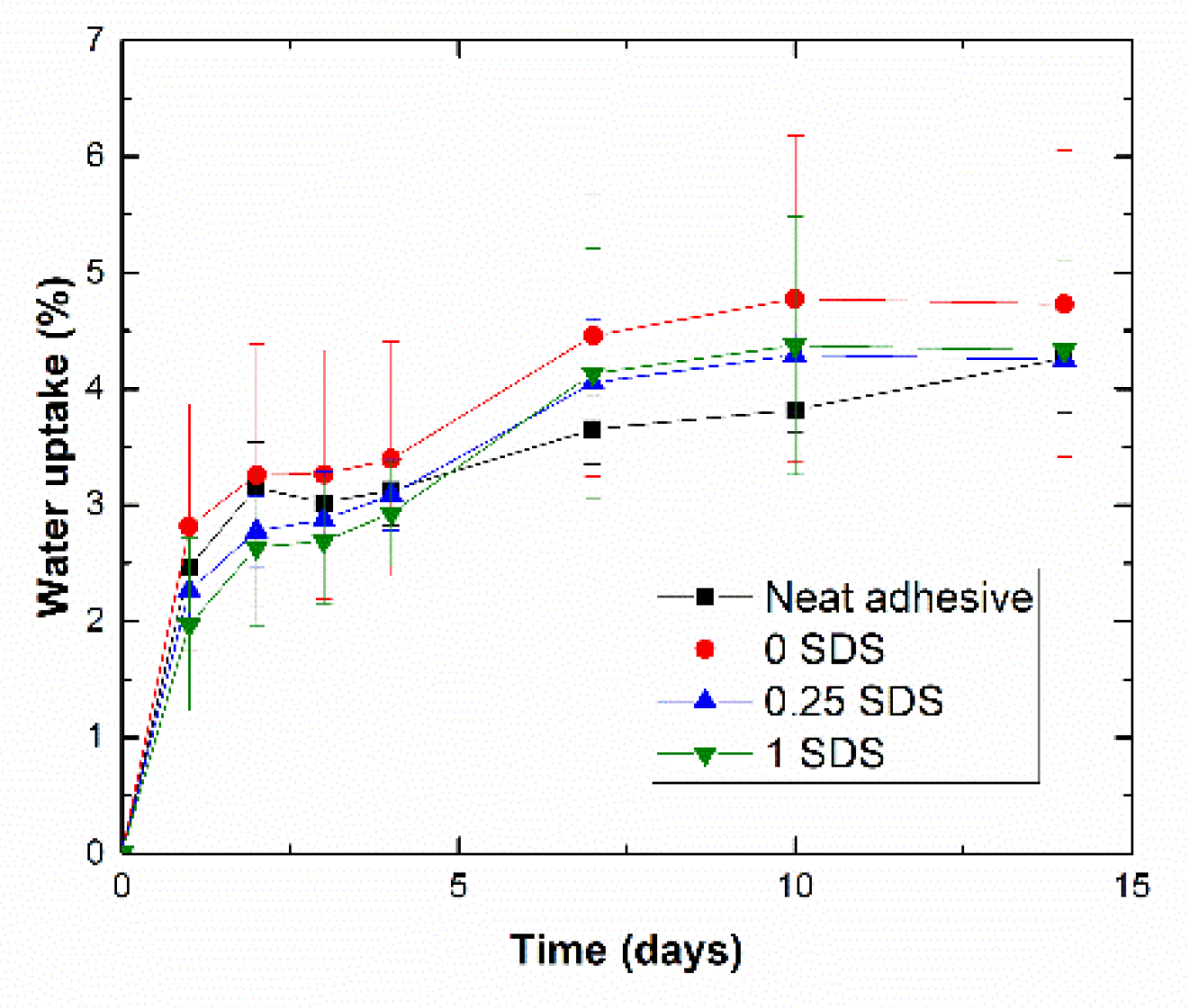
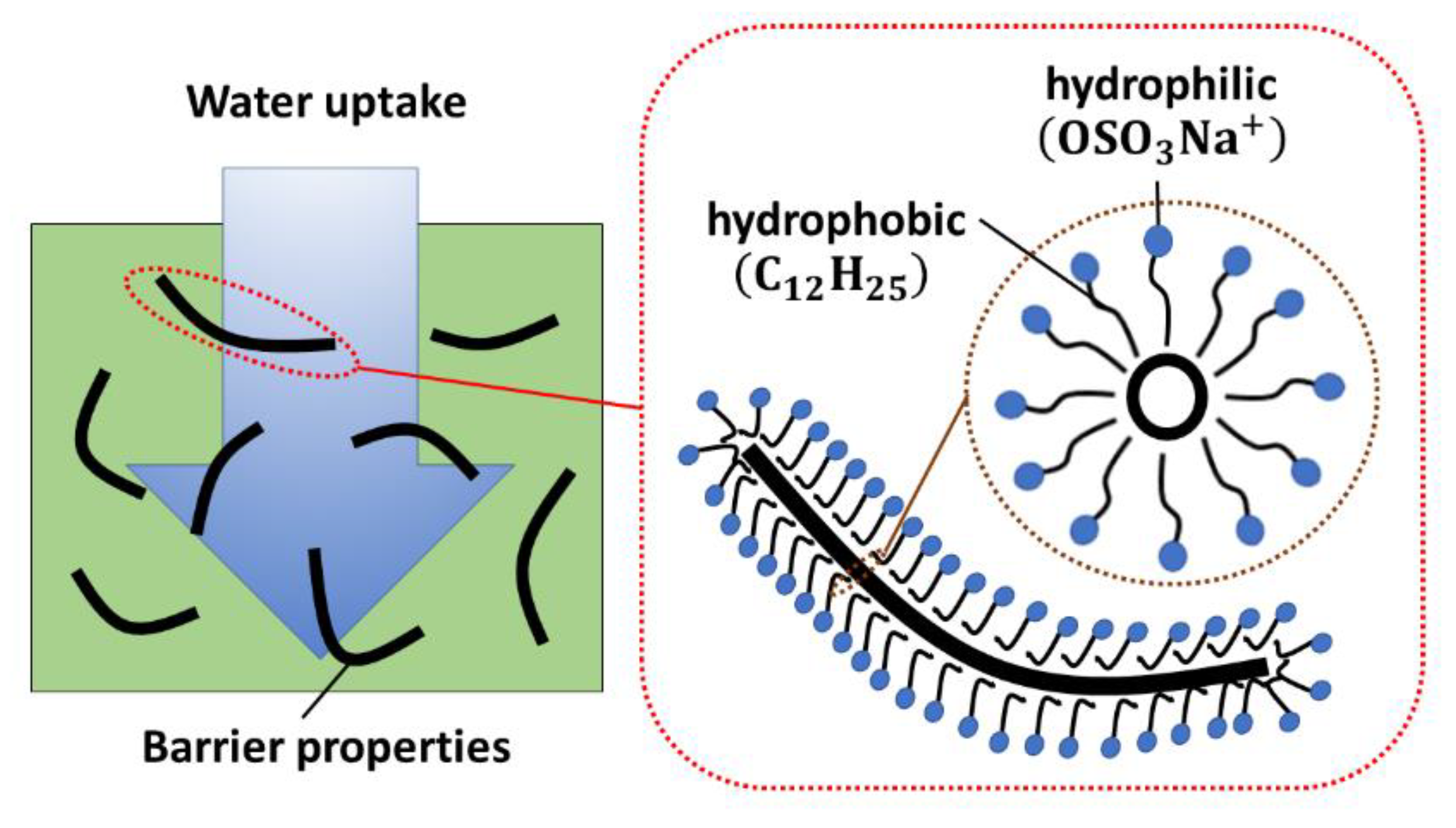
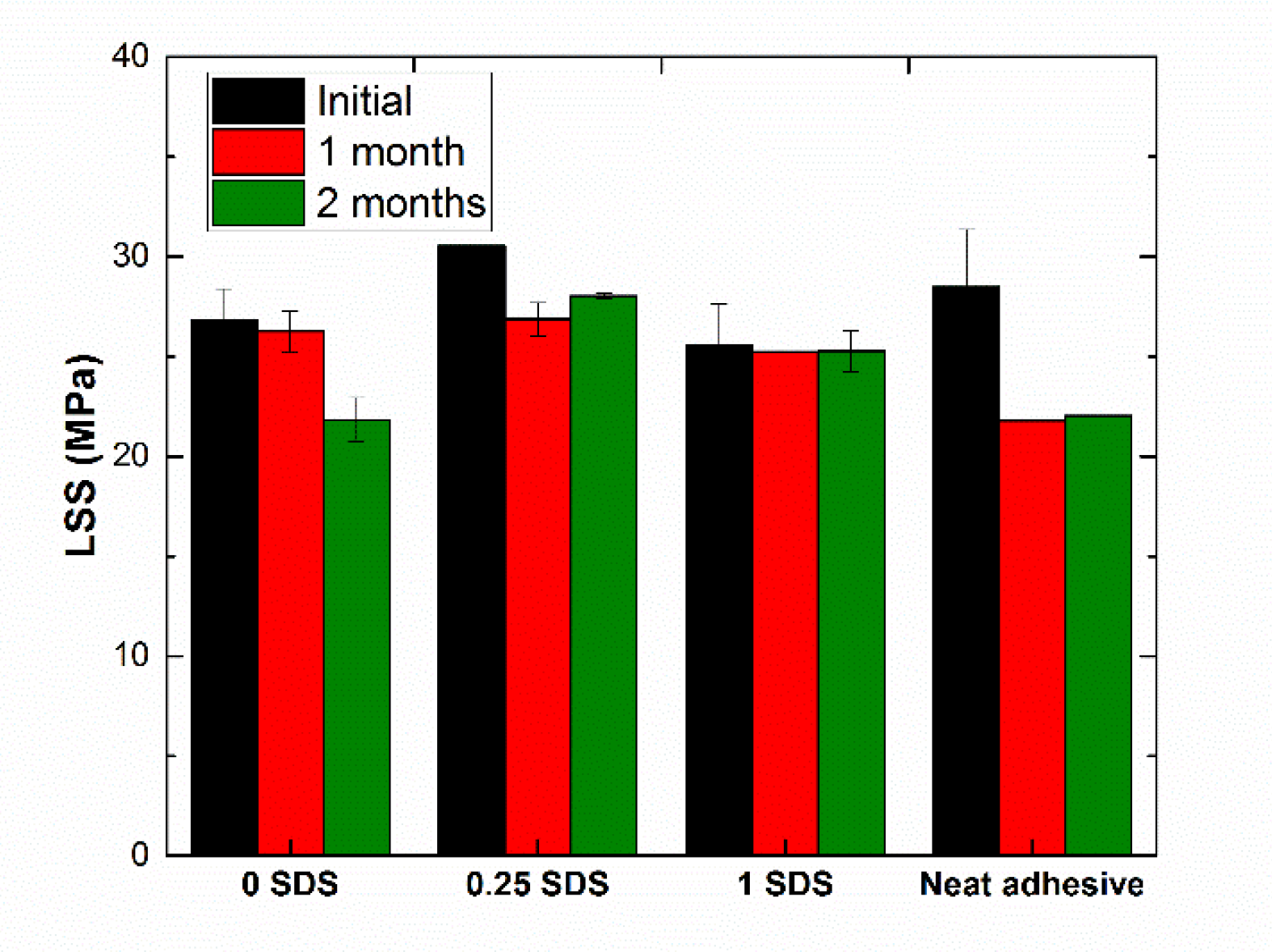
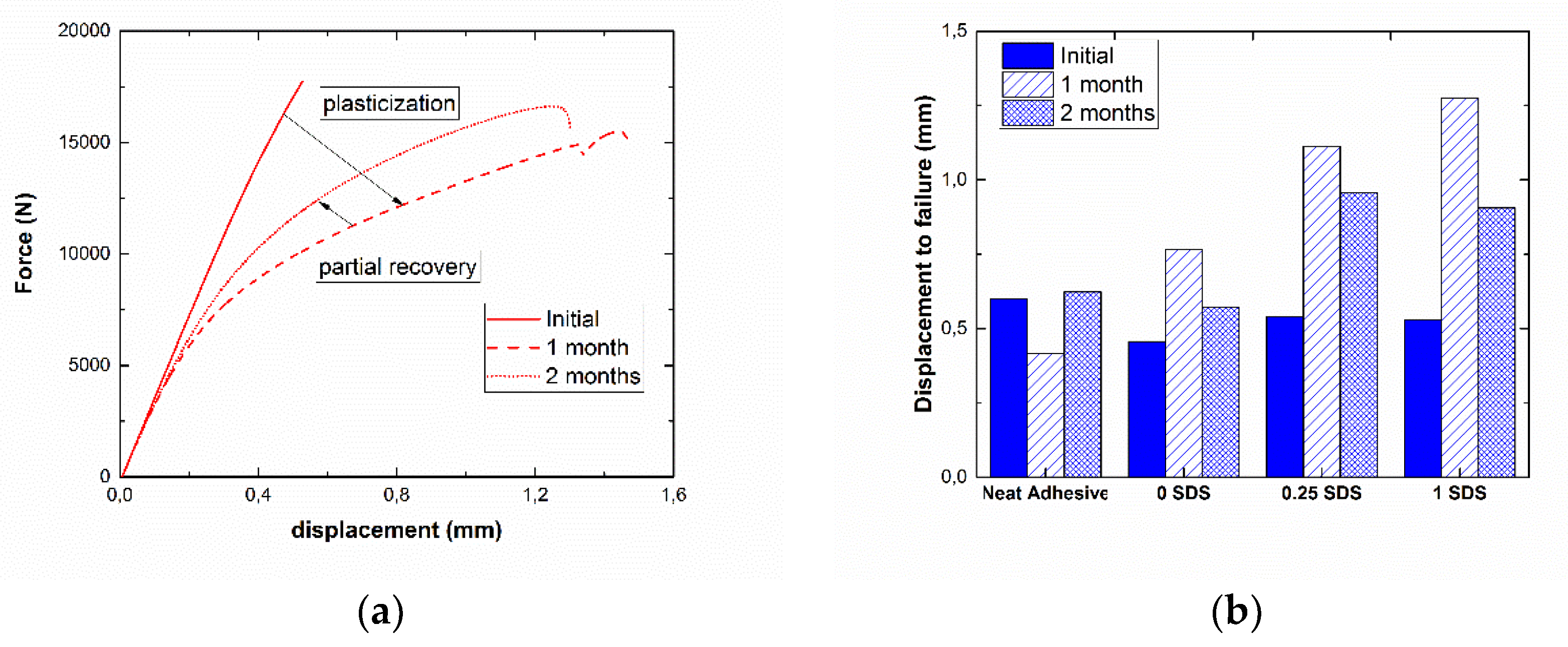
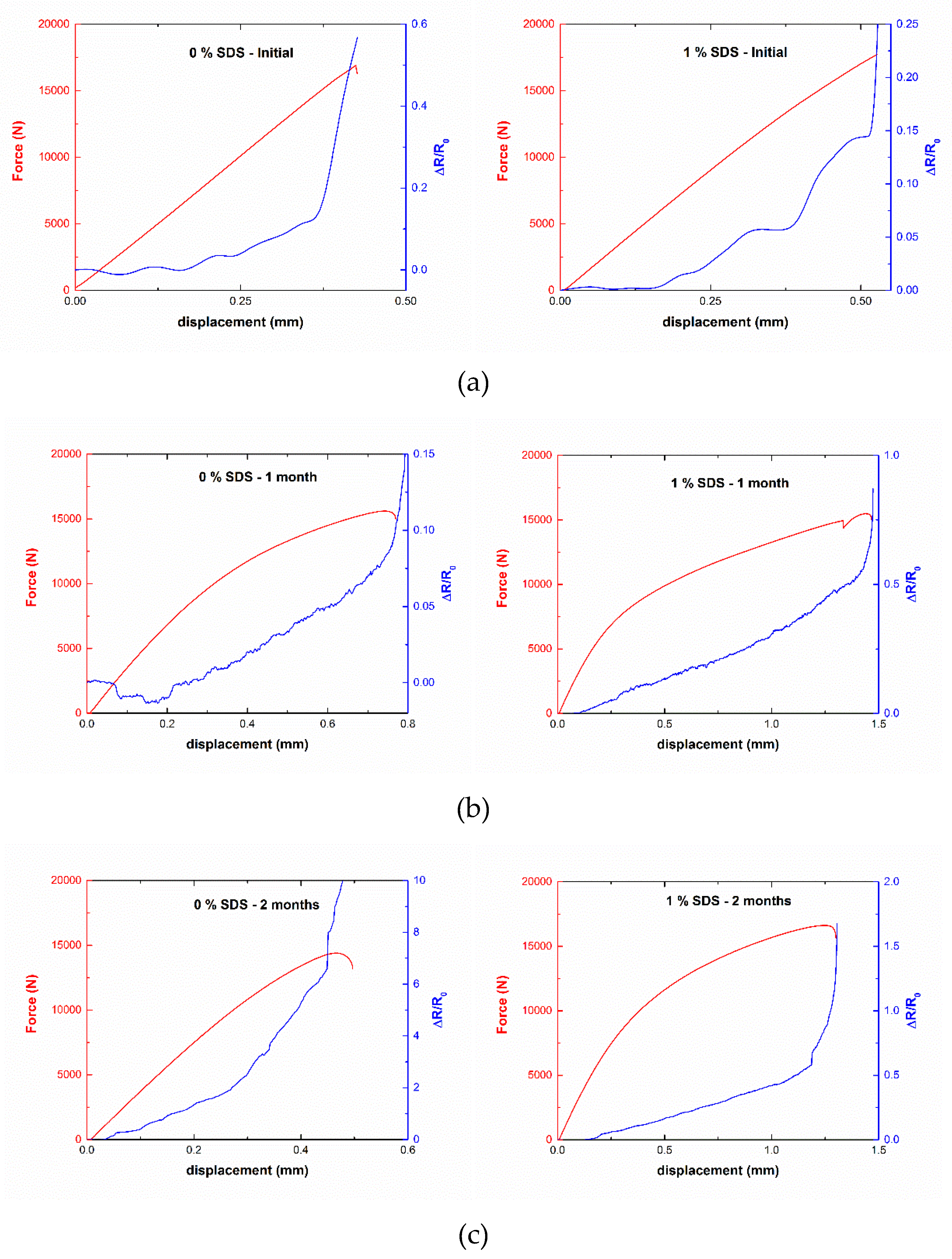
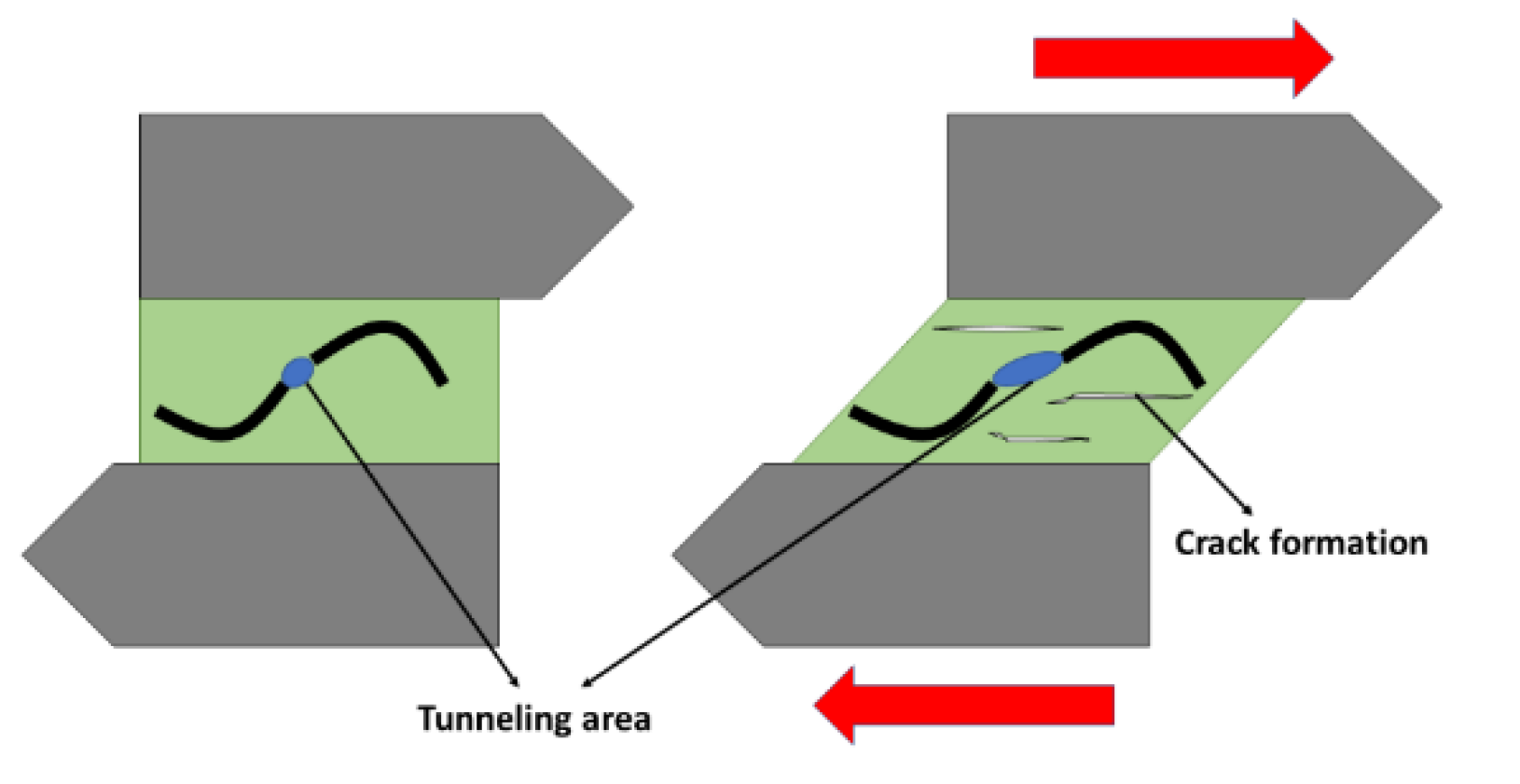
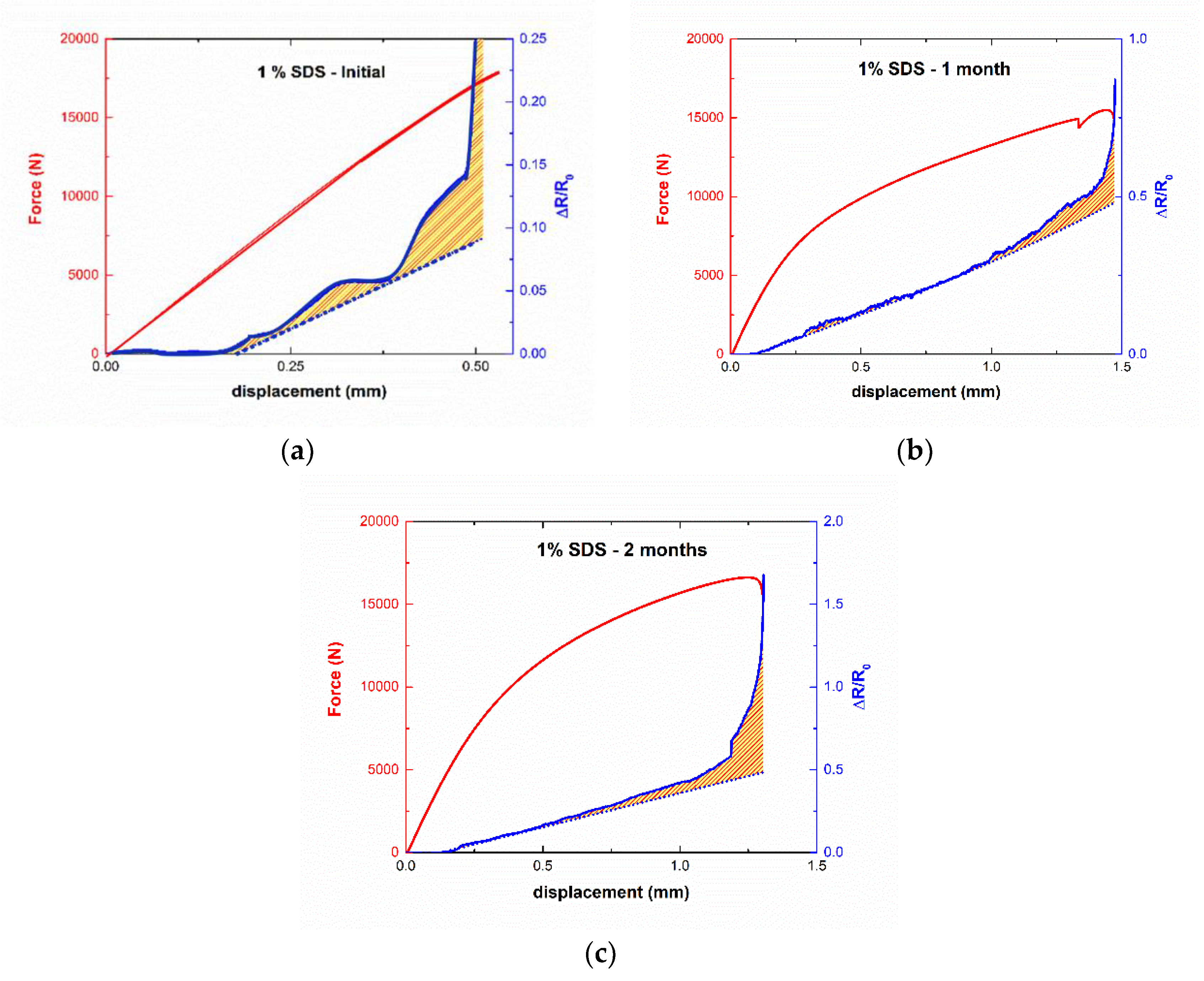
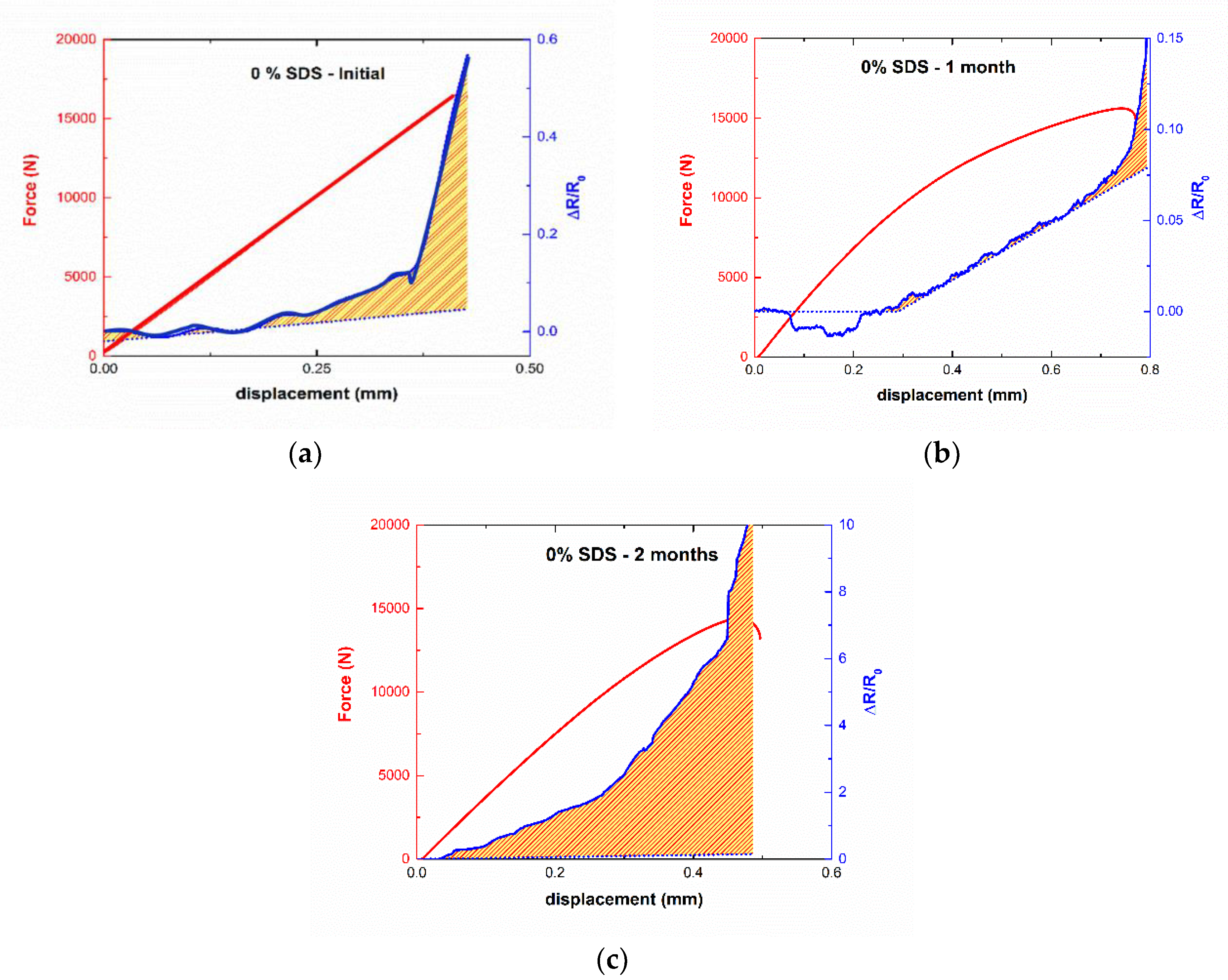
| Parameter | First Stage | Second Stage |
|---|---|---|
| Pressure | Ramp from 0 to 0.6 MPa for 15 min | 0.6 MPa for 90 min |
| Temperature | Ramp from 25 to 175 °C for 45 min | 175 °C for 60 min |
| Condition | ||||
|---|---|---|---|---|
| 1st Scanning | 2nd Scanning | 1st Scanning | 2nd Scanning | |
| Neat adhesive | 117.0 | 146.0 | 115.5 | 146.0 |
| 0.00 SDS | 144.0 | 148.0 | 119.0 | 146.0 |
| 0.25 SDS | 148.5 | 149.5 | 118.0 | 148.5 |
| 1.00 SDS | 146.0 | 147.5 | 109.0 | 149.5 |
© 2020 by the authors. Licensee MDPI, Basel, Switzerland. This article is an open access article distributed under the terms and conditions of the Creative Commons Attribution (CC BY) license (http://creativecommons.org/licenses/by/4.0/).
Share and Cite
F. Sánchez-Romate, X.; Jiménez-Suárez, A.; Sánchez, M.; G. Prolongo, S.; Güemes, A.; Ureña, A. Electrical Monitoring as a Novel Route to Understanding the Aging Mechanisms of Carbon Nanotube-Doped Adhesive Film Joints. Appl. Sci. 2020, 10, 2566. https://doi.org/10.3390/app10072566
F. Sánchez-Romate X, Jiménez-Suárez A, Sánchez M, G. Prolongo S, Güemes A, Ureña A. Electrical Monitoring as a Novel Route to Understanding the Aging Mechanisms of Carbon Nanotube-Doped Adhesive Film Joints. Applied Sciences. 2020; 10(7):2566. https://doi.org/10.3390/app10072566
Chicago/Turabian StyleF. Sánchez-Romate, Xoan, Alberto Jiménez-Suárez, María Sánchez, Silvia G. Prolongo, Alfredo Güemes, and Alejandro Ureña. 2020. "Electrical Monitoring as a Novel Route to Understanding the Aging Mechanisms of Carbon Nanotube-Doped Adhesive Film Joints" Applied Sciences 10, no. 7: 2566. https://doi.org/10.3390/app10072566
APA StyleF. Sánchez-Romate, X., Jiménez-Suárez, A., Sánchez, M., G. Prolongo, S., Güemes, A., & Ureña, A. (2020). Electrical Monitoring as a Novel Route to Understanding the Aging Mechanisms of Carbon Nanotube-Doped Adhesive Film Joints. Applied Sciences, 10(7), 2566. https://doi.org/10.3390/app10072566










